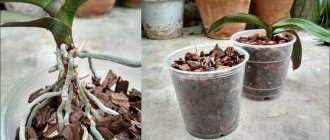In this article we will tell you the main reasons for situations in which an orchid withers.
Many varieties of orchids are quite easy to care for, contrary to popular belief, however, in order to grow a beautiful, full-fledged plant, proper care is required. In addition, it is important, in case of certain problems with a flower, to promptly diagnose and correct the situation through treatment or correcting errors in care.
Wilting orchid
Why an orchid withers is a question that periodically worries owners of exotic flowers. Sometimes this is not a cause for concern. Wilting and subsequent desiccation of the two lower leaves is a natural process in many crops. As well as the appearance of new, young leaves. However, you should worry and take action if the following symptoms appear:
- the leaves of the plant have lost turgor;
- yellowness and dullness appeared on some leaves;
- dark spots;
- wrinkling of the leaf plate;
- lethargy.
If such symptoms appear, the first thing to do is to remove the plant from other crops in a separate place. Next, you should observe the flower to figure out what causes such manifestations. During this period, it is necessary to isolate the plant from bright light, do not irrigate or fertilize. Only after establishing the exact cause can you try to revive the plant.
What does a wilted flower look like?
Sometimes the plant acquires a yellow or brown tint, its leaves begin to wrinkle, and its buds begin to fall off . In some cases, these symptoms may include a sticky discharge. The leaves become corrugated, the flowers become small and sparse. In advanced cases, tears, specks and spots can be observed on the leaves.
Important : If you do not determine the cause of the trouble and do not save the orchid, it may die.
The main reasons for orchid wilting
The most common causes of crop wilting include:
- errors in the care and maintenance of the plant;
- some diseases;
- exposure to insect pests.
There are many methods for restoring an orchid, but they can be used to determine the exact cause.
Common care mistakes
The first thing you need to pay attention to is its proximity to other indoor plants. Some types of orchids do not tolerate close proximity to other crops. In addition, for the correct development of an orchid, you must initially correctly determine its location.
Over or under watering
Sometimes the cause of wilting lies in the wrong watering regime. The fact is that irrigation is important for orchids, but crop owners often forget about this. With constant changes in the microclimate in the room, you need to constantly monitor the substrate. To determine humidity, you need to touch the flower. If it moves, the soil is too dry.
Determining whether a plant is rotting due to overwatering is a little more difficult. Externally, rotting is not noticeable; often the plant even blooms during this period. You need to carefully examine the root system. If blackness is visible on the roots, it means that the orchid was regularly flooded.
Dense soil
Proper soil largely determines the full development of the plant. The high-quality substrate that an orchid requires does not retain moisture and nourishes the plant with all the necessary nutrients. It is important to remember that the substrate needs to be changed every 2-3 years.
Overheating or hypothermia
The orchid does not like direct sunlight, so you should not place it on a windowsill on the south side of the house. The plant will react negatively to heating devices located near the orchid. These factors have a detrimental effect on culture. The flower is designed in such a way that at the slightest overheating it immediately begins to evaporate moisture.
Drafts and hypothermia of the roots also have a bad effect on the plant. For this reason, there is no need to place the plant on a window during the cold season. To prevent the root system from freezing, experienced gardeners place a small foam plate under the pot.
Insect pests
As a result of the influence of certain parasites that eat up the roots of the orchid, the plant loses its ability to absorb nutrients and water necessary for the crop. As a result of the attack of parasites, the laying of larvae in the top layer of soil, the leaves of the plant wither.
Why is this happening?
The wilting of a fragile flower can begin for several reasons.:
The first thing that comes to our mind when we see a wilting orchid is that it needs more water. However, this is not always the case. If only the lower leaves of a phalaenopsis wither, this means that having given all the nutrients to its upper “brothers,” it will soon dry out. This is a healthy, normal process that does not require intervention.- The pot is too cramped, where the orchid’s root system is too compressed.
- If the watering regime has been disrupted and the orchid has long been “thirst” for direct rays of the sun. Dry air, a room with heating and no humidifier do not help the orchid to bloom.
- Root rotting. Orchids from the supermarket, wrapped in plastic and planted in cramped pots without holes, are watered abundantly, but there is nowhere for the excess moisture to evaporate.
- Excessive fertilization. The roots of the plant receive a kind of “burn”.
- Pests: aphids, scale insects, spider mites and others.
- Ethylene gas from heaters that use propane or kerosene for fuel can poison orchid buds! Paint fumes and tobacco smoke also do not contribute to a healthy atmosphere.
Methods for treating orchids
Once the cause of the plant's wilting is discovered, treatment can begin. The orchid is a fairly resilient plant and is more likely to be revived.
The simplest methods include getting rid of pests using special preparations, watering when the substrate is dry, irrigating the leaves, and wiping with a damp cloth. You can revive the plant by adjusting the watering, irrigation, and fertilizing regimes.
More complex measures include trimming the roots, getting rid of dry or rotten elements, changing the substrate, transplanting into another, more spacious pot, treating the root system with special means.
Transplant technology
If an orchid withers, you need to do an urgent transplant, especially when rotten, dry, injured roots are found. The technology consists of the following steps:
- carefully free the roots from the old substrate;
- carefully examine the roots;
- rinse them carefully under warm running water;
- Use a sharp sterile knife to cut off rotten and dry shoots;
- treat the sections with activated carbon.
Next, you need to leave the orchid without a substrate for several weeks. Then select a suitable pot, a substrate with the correct ratio of the necessary elements and plant the orchid.
Problems with the root system
The orchid has aerial roots, so assessing their condition directly in the pot is not difficult. The plant does not even have to be dug out of the ground and put under additional stress. This is where you should start to understand the reasons why the leaves began to fade.
Healthy roots have good turgor and a silver or green color; they are dense and smooth.
New roots are light, but when lowered into water they turn green. Darkening and discoloration closer to black or brown indicates that these parts are rotting. They feel slimy to the touch, and when pressed, liquid may leak out.
First of all, this is due to a lack of oxygen. Due to poor air exchange, the leaves are limp, wrinkled and wrinkled. You can save the plant by replanting it in a looser substrate in a pot with holes for ventilation.
The second option for the development of pathology is that the roots dry out. Causes: diseases, excessive and insufficient watering, etc.
So, if the orchid begins to wither and drop its buds when flowering, look at the root system.
A problem with the roots leads to disruption of the flower’s nutrition and respiration, which subsequently dies. The affected plant requires replanting.
Withering of different parts of the orchid
The lethargy of different parts of the plant depends on certain reasons.
Butonov
Wilting of buds may be due to the fact that the plant does not have the strength to flower after the buds form. Other causes include pest attacks or fungal infections.
Root system
Roots can lose turgor due to an excess of fertilizers, exposure to heat, mechanical damage that is difficult to detect immediately, or fungal diseases. You also need to check the pot - perhaps it is too small for the roots to develop.
Leaf blades during flowering
The orchid spends all its energy on flowering. A healthy plant copes well with this, but if the crop is weakened, it lacks the ability to provide the necessary nutrition to the leaves.
After the purchase
If the orchid withers after purchase, you need to check the soil, since it is often not intended for the normal development of the plant. You should also pay attention to the pot - whether it matches the size of the crop. It is possible that wilting immediately after purchase is a plant reaction to stress.
What to do if flowers fade?
What a pity when luxurious buds suddenly fall off. There are reasons for everything. A plant is also a living being.
The factors that cause these processes are almost the same as with wilting and falling leaves. Let's just add a few things.
Changing your place of residence does not always bring pleasure. Orchids tolerate this especially hard. You bought a gorgeous flowering plant. They brought it home. This is where the trouble started. Just moving plus a new place has such an impact on your beauty. A different climate, different living conditions are enough for the flowers to begin to fall.
- Natural aging
Withering, falling, dying is a natural process. There is no eternal bloom. Some delight us with beautiful buds for a week or two. Others – several months. In addition, it is not known how long the phalaenopsis bloomed before you purchased it. Perhaps this period was just ending at the time of purchase.
- Hypothermia
Orchids are heat-loving. Transporting it in winter is one of the causes of the problem. Even when it is well packaged. At home, the temperature can also be lower than permissible. Set at 22 – 32 degrees. Depends on the periods. Stick to routines. Especially air humidity. The average rate is 70%. Its deficiency also serves as a factor in the fall of flowers.
- Draft
Orchids need good air circulation. But a draft has a detrimental effect. It is enough to ventilate the room thoroughly.
- Location near food outlets
Especially vegetables and fruits. Some of them emit ethylene. This gas stimulates the ripening of flowers, even unopened buds. Rapid ripening leads to rapid withering. Therefore, remove all products from the flower.
- Pollination
During warm periods, the pot is taken out to the open balcony to “breathe.” Small insects pollinate the plant. When everything happened successfully, the fading flower will be replaced by a seed pod. If not, then it will disappear.
- Pests
Mealybugs especially contribute to damage. He loves the juice of the buds. Externally it looks like cotton wool. Leaves behind a sticky residue.
Prevention
To prevent premature wilting of an orchid, you need to follow the simple recommendations of experienced gardeners:
- the culture should be inspected frequently;
- treat pests in a timely manner;
- provide adequate lighting;
- establish the correct watering and irrigation regime in accordance with the humidity in the room;
- form the soil correctly and change it in a timely manner.
You should also take seriously the choice of a permanent place for culture. The orchid does not tolerate direct sunlight, drafts, or heat.
How to grow an orchid at home
When growing flowers, gardeners face various difficulties that are associated with the characteristics of the crop. The orchid's leaves wither or buds fall off. If the rules of care are violated, the leaves often turn yellow and wither, and may fall off or curl. Home orchids are grown in different ways, choosing the option that suits a particular variety and takes into account the characteristics of the crop. Ordinary soil is not suitable for them; soil is purchased from specialized flower shops.
Placement, growing container
As a planting container, choose a transparent pot, which is equipped with a drainage system. Drainage holes should be located along the bottom and sides. The transparency of the pot allows you to monitor the condition of the substrate and the growth of the root system. An alternative planting option is to place it on the bark of a suitable tree. This method is close to natural conditions, but is only suitable for experienced gardeners. The soil for pot plantings consists of bark, sphagnum, sand, and charcoal.
Lighting
For flowers, choose southern or western windows during the warm season. In winter or autumn, the location is changed. If there is a lack of light, install additional lamps.
Irrigation
An important condition for caring for indoor flowers. Watering is carried out after assessing the external condition. If the orchid has limp leaves, the pot has become light, and there are no drops of condensation on its walls, then watering is necessary. It is carried out using the pallet method. This means that a pot with drainage holes is placed on a tray filled with warm, settled water and left until the roots are completely saturated.
Fertilizing
For fertilization, solutions with nutrients are used. Most often, root watering is done with the selected concentration. One of the feeding options is to place soluble tablets at the bottom of the pot.
Substrate
Regular soil is not suitable for these flowers. They use tree bark of different fractions, drainage and sphagnum moss. The bark allows moisture to pass through well and remains moist for a long time, which is close to natural growth conditions and the natural habitat.
Warning! Excessive waterlogging leads to rotting of the roots. Plants are watered only when the substrate becomes completely dry.
Basics of proper orchid care
To prevent your orchid leaves from drying out again, properly care for it. This plant loves:
- High quality lighting . The duration of daylight should be at least 12 hours. If you do not have a window facing the sun, place a phytolamp next to the orchid. Turn it on when the sun's rays stop falling on the leaves of the plant.
- Regular watering . Water your orchid thoroughly whenever its substrate becomes dry. Ensure good drainage to prevent standing water. Then the overflow of soil will be excluded.
- Regular feeding. During the period of active growth and flowering, do not forget to feed the orchid. The recommended frequency is once every 2 weeks. Fertilizing is combined with watering. Give preference to mineral or organomineral fertilizers designed specifically for orchids.
- Loose soil . Try to loosen the substrate after each watering. This promotes soil aeration and prevents stagnation, which provokes the development of fungal diseases.
- Warm and humid air . The optimal air temperature for orchids is about 20 °C. At night, do not allow the temperature to drop below 15 ° C. During the day, try not to raise it to 30 °C or higher. If the air is dry, moisten it with improvised means (containers of water, wet laundry) or a special air humidifier.
Advice! To prevent fungal diseases of an orchid, spray it once a week with a solution of Fitosporin. This is a safe remedy with a weak antifungal effect. To treat a fungus that has already appeared, it is better to use powerful fungicides.
Take proper care of your orchid, and it will stop withering, the stems and leaves will become stronger, and flower stalks will appear. A healthy plant will delight you with long-lasting flowering and a pleasant aroma that fades in the morning or evening.











